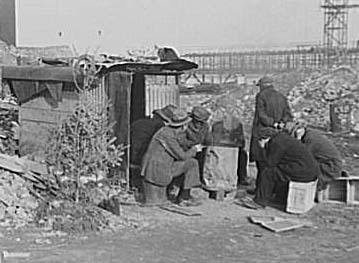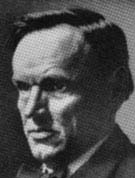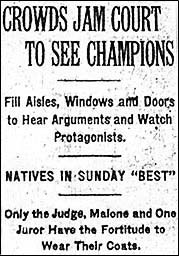Location:Akron, Ohio
On its surface, the case of Ray LeDoux was typical of the Depression
era. A young man, out in the world alone, gets bitten by vampires and
has to be destroyed by FVZA agents. But the Ray LeDoux case would prove
to have a life of its own, a life that almost brought about the end of
the FVZA.
 |
A hobo camp
near Chicago |
Background: Ray LeDoux grew up in a prosperous middle-class Ohio
home, the son of an insurance company owner and a homemaker. Like many
teenagers at that time, Ray was taken by the romance of the rails.
During the summer of 1923, Ray and a friend embarked on one last
adventure before college. They hopped a train in Akron and set off
westward, overnighting in hobo camps along the way. The postcards Ray
sent back home chronicle his journey: Illinois, Iowa, Nebraska. And
then, late in June of 1923, the postcards abruptly stopped.
Incident:On the night of July 1, 1923, a hobo camp in the shadow
of a trestle bridge along the Mississippi River was attacked by a pack
of vampires. Six hobos were bitten; three escaped harm. By the time
the FVZA Saint Louis team arrived, the vampires had vanished. One night
later, another hobo camp was hit, this one 200 miles to the east near
Indianapolis. A third attack took place one night later near Columbus,
Ohio.
 |
FVZA agents inspect
the train that
carried the vampires |
Investigation: An FVZA team from Cleveland, Ohio, deduced that
the vampire pack was using the railroad to flee from their crime scenes.
A quick study of railroad timetables led the team to a railyard in
Dayton, Ohio, on the afternoon of July 5, 1923. The team conducted a
search of all the trains in the yard, using dogs. The dogs quickly ran
to one vacant boxcar and began barking excitedly. The team surrounded
the car and flushed out seven vampires, who were then destroyed. Among
them was a teenage boy with identification bearing the name "Ray
LeDoux."
 |
| Clarence Darrow |
Post-Mortems: On July 6, 1923, two FVZA agents arrived at the
home of Ray LeDoux' parents in Akron to give them the bad news. LeDoux
was buried shortly thereafter, and the matter seemed to be closed. But a
week after the funeral, the LeDoux family announced that they had hired
the great lawyer Clarence Darrow to pursue a wrongful death lawsuit
against the FVZA. At a press conference, Darrow told the assembled
reporters, "the FVZA operates as judge, jury and executioner. They are
like a closed, secret society within the confines of the United States
Government, and it is high time we open them up for inspection."
 |
The nation's newspapers
followed the trial closely |
Throughout August of 1923, the LeDoux trial captivated the nation. The
trial, held in Akron, turned into a showdown between the nation's two
most prominent lawyers: Clarence Darrow for the LeDoux family, and
William Jennings Bryan for the FVZA. Darrow's central point was that a
person bitten by a vampire had committed no crime and thus had the same
rights as any American citizen, including the right to trial by jury.
William Jennings Bryan countered that capturing vampires and holding
them for trial was absurdly dangerous and impractical. "What if the
vampire is found innocent," Bryan asked. "Do we release it on its own
recognizance?"
 |
The Akron courtroom
as it looks today |
In his closing argument, Darrow played on the jury's emotions. Rather
than dwell on vampirism, he spoke of Ray LeDoux, the honor student,
paperboy and fishing enthusiast. He even read some of the postcards Ray
had sent back from his railway adventures. The jury was moved, and
came in with a verdict against the FVZA. Trial judge Gavin Conley went a
step further: he slapped a moratorium on the killing of vampires in
Ohio. Despite vehement protests from many quarters, the Ohio State
Supreme Court upheld the verdict.
Fortunately, by the time the case got to the Supreme Court, the folly of
the Ohio decision had become clear. Numerous FVZA agents quit and,
when ill-trained army troops were thrown into the fray, vampire attacks
exploded. Finally, on November 3, 1923, the Supreme Court reversed the
ruling of the Ohio judge and restored the Agency's right to destroy
vampires. In the majority decision, Chief Justice and former President
William Howard Taft wrote, "the FVZA provides a great service to our
country, and the Court should not do anything to prevent them from the
fulfillment of that service."
Comments from Dr. Pecos: Sadly, Chief Justice Taft's words were
not heeded by future court justices. In 1935, the Supreme Court
declared that vampires have the same rights as all citizens. The ruling
essentially stripped away the FVZA's Powers of Termination, also known
as the Right to Kill. In response, President Franklin Roosevelt signed
the Emergency Relief Act of 1936, which turned the Agency into an
undercover operation. For the next 39 years, the Agency did its brave
work in the shadows, far from the prying eyes of the legal system.






No comments:
Post a Comment